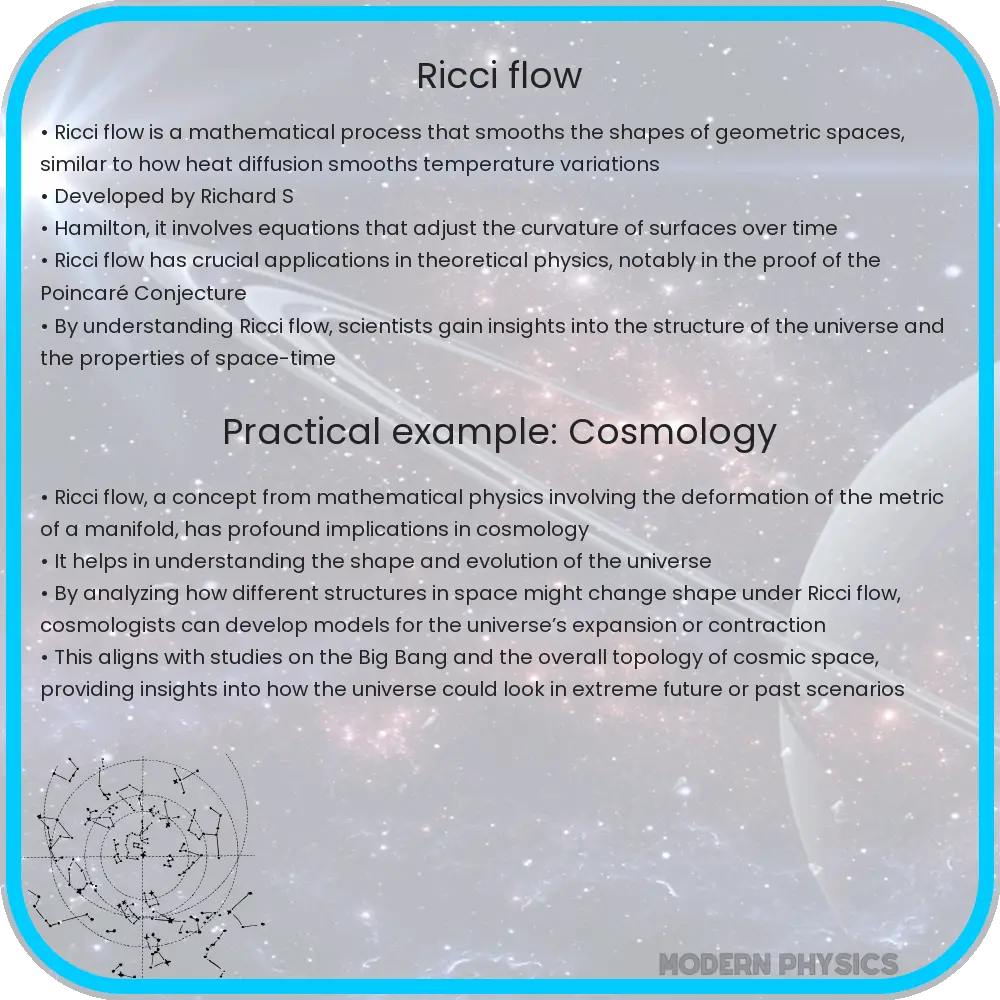Ricci Flow: A mathematical concept introduced by Richard S. Hamilton in 1982, describing the evolution of shapes and surfaces, with significant applications in General Relativity.

Ricci Flow: General Relativity Insights & Applications
Ever wondered how complex shapes and surfaces evolve over time? The concept of Ricci Flow, introduced by Richard S. Hamilton in 1982, provides a powerful tool for understanding this evolution in the realm of differential geometry. It’s a fascinating area that has significant implications, especially in the field of General Relativity.
What is Ricci Flow?
Ricci Flow is an equation that describes the deformation of the metric (a way to measure distances) of a Riemannian manifold. Mathematically, it can be expressed as:
\[
\frac{\partial g_{ij}}{\partial t} = -2 R_{ij}
\]
Here, \( \frac{\partial g_{ij}}{\partial t} \) represents the time derivative of the metric tensor \( g_{ij} \), and \( R_{ij} \) is the Ricci curvature tensor. Essentially, Ricci Flow works by smoothing out irregularities in the shape, much like how the heat equation smooths out temperature distributions over time.
Ricci Flow in General Relativity
General Relativity, formulated by Albert Einstein, describes the gravitational interaction as a result of the curvature of spacetime. The Einstein Field Equations (EFE) are central to this theory, which can be written as:
Gμν = 8πTμν
Where Gμν is the Einstein tensor, representing the curvature of spacetime, and Tμν is the stress-energy tensor, representing the matter and energy content. The Ricci tensor, which plays a crucial role in Ricci Flow, is also a part of the Einstein tensor.
In General Relativity, the Ricci tensor \( R_{ij} \) represents certain types of gravitational fields, especially those associated with the matter distribution in the universe. Through Ricci Flow, the geometry of the manifold evolves over time, potentially leading to more symmetrical and simplified representations of these gravitational fields.
Applications of Ricci Flow
The applications of Ricci Flow extend beyond theoretical mathematics and into practical physical theories. Some key applications include:
- Uniformization of Geometry: Ricci Flow can help to classify and uniformize different geometric structures, making it easier to understand the global properties of the universe.
- Insights into Black Holes: By applying Ricci Flow to the metrics of spacetime around black holes, scientists can better understand their complex geometry and evolution.
- Cosmology: In the study of the universe’s evolution, Ricci Flow assists in modeling the large-scale structure of the cosmos, including the behavior of galaxies and clusters.
Ricci Flow and the Poincaré Conjecture
One of the most celebrated applications of Ricci Flow is its role in the proof of the Poincaré Conjecture. Proposed by Henri Poincaré in 1904, this conjecture posits that any closed three-dimensional manifold without holes is topologically equivalent to a three-dimensional sphere. This long-standing mathematical puzzle was finally proven in 2003 by Grigori Perelman using Ricci Flow with surgery.
Perelman’s breakthrough involved carefully analyzing the singularities that develop during the Ricci Flow and using a process called surgery to cut them out and continue the flow. This approach not only solved the Poincaré Conjecture but also contributed significantly to our understanding of three-dimensional geometric structures.
Challenges and Future Directions
Despite its powerful applications, Ricci Flow is not without its challenges. One significant obstacle is the development of singularities, where the curvature becomes infinite, making the mathematical equations difficult to handle. Various techniques like Ricci Flow with surgery have been developed to manage these singularities, but this remains a complex and active area of research.
Looking ahead, the future of Ricci Flow research may include:
- Higher Dimensions: Extending the applications of Ricci Flow to higher-dimensional manifolds could provide new insights into complex geometric and physical theories.
- Quantum Gravity: Understanding how Ricci Flow interacts with quantum mechanics could pave the way for advancements in the quest for a unified theory of quantum gravity.
- Computational Approaches: Developing advanced computational methods to simulate Ricci Flow could make it accessible for solving practical problems in physics and engineering.
Conclusion
Ricci Flow, initially a concept in differential geometry, has found remarkable applications in both mathematics and physics, particularly in General Relativity. By enabling the smooth evolution and classification of various geometric structures, it has provided crucial insights into the nature of spacetime, black holes, and the universe at large. Despite the complexities and challenges associated with singularities, ongoing research continues to unveil new horizons for Ricci Flow, making it a fascinating and ever-relevant field of study. Whether you are a mathematician, physicist, or just a curious mind, delving into the world of Ricci Flow can broaden your understanding of the underlying structures of our universe.
